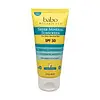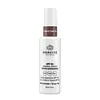babo botanicals Sheer Mineral Sunscreen Lotion SPF 50 Versus Odacité California SPF 50 Tinted Mineral Drops
What's inside
What's inside
 Key Ingredients
Key Ingredients

 Benefits
Benefits

 Concerns
Concerns

 Ingredients Side-by-side
Ingredients Side-by-side

Zinc Oxide 20%
Cosmetic ColorantWater
Skin ConditioningHelianthus Annuus Seed Oil
EmollientCocos Nucifera Oil
MaskingButyloctyl Salicylate
Skin ConditioningCarthamus Tinctorius Seed Oil
MaskingMethyl Dihydroabietate
Butyrospermum Parkii Butter
Skin ConditioningCetearyl Alcohol
EmollientSodium Stearoyl Glutamate
CleansingMicrocrystalline Cellulose
AbsorbentCalendula Officinalis Flower Extract
MaskingChamomilla Recutita Flower Extract
MaskingNasturtium Officinale Flower/Leaf Extract
AntiseborrhoeicSpiraea Ulmaria Flower Extract
Skin ConditioningTheobroma Cacao Seed Butter
EmollientBisabolol
MaskingTocopherol
AntioxidantCetyl Alcohol
EmollientCaprylyl Glycol
EmollientCoco-Glucoside
CleansingBehenyl Alcohol
EmollientArachidyl Glucoside
EmulsifyingArachidyl Alcohol
EmollientPolyhydroxystearic Acid
EmulsifyingCitric Acid
BufferingSodium Gluconate
Skin ConditioningSodium Hyaluronate
HumectantGlycerin
HumectantCaprylhydroxamic Acid
Cellulose Gum
Emulsion StabilisingZinc Oxide 20%, Water, Helianthus Annuus Seed Oil, Cocos Nucifera Oil, Butyloctyl Salicylate, Carthamus Tinctorius Seed Oil, Methyl Dihydroabietate, Butyrospermum Parkii Butter, Cetearyl Alcohol, Sodium Stearoyl Glutamate, Microcrystalline Cellulose, Calendula Officinalis Flower Extract, Chamomilla Recutita Flower Extract, Nasturtium Officinale Flower/Leaf Extract, Spiraea Ulmaria Flower Extract, Theobroma Cacao Seed Butter, Bisabolol, Tocopherol, Cetyl Alcohol, Caprylyl Glycol, Coco-Glucoside, Behenyl Alcohol, Arachidyl Glucoside, Arachidyl Alcohol, Polyhydroxystearic Acid, Citric Acid, Sodium Gluconate, Sodium Hyaluronate, Glycerin, Caprylhydroxamic Acid, Cellulose Gum
Zinc Oxide 12%
Cosmetic ColorantWater
Skin ConditioningC12-15 Alkyl Benzoate
AntimicrobialCaprylic/Capric Triglyceride
MaskingJojoba Esters
EmollientPropanediol
SolventTridecyl Salicylate
Skin ConditioningPolyglyceryl-4 Diisostearate/Polyhydroxystearate/Sebacate
EmulsifyingMethylheptyl Isostearate
Skin ConditioningNiacinamide
SmoothingNylon-12
Methylpropanediol
SolventSilica
AbrasiveCoco-Caprylate
EmollientSodium Chloride
MaskingPolyglyceryl-2 Dipolyhydroxystearate
Skin ConditioningBisabolol
MaskingAllantoin
Skin ConditioningOryza Sativa Bran Extract
Skin ConditioningLecithin
EmollientCaprylyl Glycol
EmollientGlycerin
HumectantHelianthus Annuus Flower Extract
Skin ConditioningTetrasodium Glutamate Diacetate
Phenylpropanol
MaskingTocopherol
AntioxidantRosmarinus Officinalis Leaf Extract
AntimicrobialChamomilla Recutita Flower Extract
MaskingCalendula Officinalis Flower Extract
MaskingCamellia Sinensis Leaf Extract
AntimicrobialPotassium Sorbate
PreservativeSodium Benzoate
MaskingSodium Hydroxide
BufferingTitanium Dioxide
Cosmetic ColorantIron Oxides
Zinc Oxide 12%, Water, C12-15 Alkyl Benzoate, Caprylic/Capric Triglyceride, Jojoba Esters, Propanediol, Tridecyl Salicylate, Polyglyceryl-4 Diisostearate/Polyhydroxystearate/Sebacate, Methylheptyl Isostearate, Niacinamide, Nylon-12, Methylpropanediol, Silica, Coco-Caprylate, Sodium Chloride, Polyglyceryl-2 Dipolyhydroxystearate, Bisabolol, Allantoin, Oryza Sativa Bran Extract, Lecithin, Caprylyl Glycol, Glycerin, Helianthus Annuus Flower Extract, Tetrasodium Glutamate Diacetate, Phenylpropanol, Tocopherol, Rosmarinus Officinalis Leaf Extract, Chamomilla Recutita Flower Extract, Calendula Officinalis Flower Extract, Camellia Sinensis Leaf Extract, Potassium Sorbate, Sodium Benzoate, Sodium Hydroxide, Titanium Dioxide, Iron Oxides
Ingredients Explained
These ingredients are found in both products.
Ingredients higher up in an ingredient list are typically present in a larger amount.
Bisabolol is famous for its skin soothing properties. It does this by blocking inflammatory signals, helping to reduce your body's reaction to irritation.
This ingredient also interferes with the process of hyperpigmentation. This can help with reducing dark spots and uneven tone.
Bisabolol is an antioxidant. Antioxidants help fight free-radicals. Free-radicals are molecules that may damage your skin cells. By fighting these free-radicals, Bisabolol may slow down signs of aging.
Studies have shown Bisabolol to have antimicrobial properties and may be a fungicide. These properties help preserve a product's shelf life.
All these properties makes bisabolol a great skin barrier helper ingredient.
Bisabolol also helps the absorption of other ingredients.
Note: Synthetic Bisabolol has been shown to be less effective.
Learn more about BisabololCalendula Officinalis Flower Extract comes from the common Marigold plant. This ingredient is a skin conditioner.
Marigolds contain flavonoids. Flavonoids are a group of substances found naturally in plants. They possess antioxidant and inflammation properties.
This ingredient soothes skin inflammation by inhibiting inhibiting a part of the inflammation process.
Marigolds have been used in traditional medicine throughout Asia and Europe.
Learn more about Calendula Officinalis Flower ExtractCaprylyl Glycol is a humectant and emollient, meaning it attracts and preserves moisture.
It is a common ingredient in many products, especially those designed to hydrate skin. The primary benefits are retaining moisture, skin softening, and promoting a healthy skin barrier.
Though Caprylyl Glycol is an alcohol derived from fatty acids, it is not the kind that can dry out skin.
This ingredient is also used as a preservative to extend the life of products. It has slight antimicrobial properties.
Learn more about Caprylyl GlycolChamomilla Recutita Flower Extract comes from the Chamomile flower.
Chamomile is rich in antioxidants and has anti-inflammatory properties. Several compounds found in chamomile help with soothing, such as bisbolol.
Antioxidant components in chamomile make it an effective ingredient to help slow the signs of aging. Antioxidants help fight free-radical molecules, or molecules that may damage your skin.
Essential oils from chamomile have been found to improve wound healing due to its antimicrobial properties.
Ancient Greeks and Egyptians used Chamomile to treat skin redness and dryness. Chamomile has also been used to help treat stomach issues.
Learn more about Chamomilla Recutita Flower ExtractGlycerin is already naturally found in your skin. It helps moisturize and protect your skin.
A study from 2016 found glycerin to be more effective as a humectant than AHAs and hyaluronic acid.
As a humectant, it helps the skin stay hydrated by pulling moisture to your skin. The low molecular weight of glycerin allows it to pull moisture into the deeper layers of your skin.
Hydrated skin improves your skin barrier; Your skin barrier helps protect against irritants and bacteria.
Glycerin has also been found to have antimicrobial and antiviral properties. Due to these properties, glycerin is often used in wound and burn treatments.
In cosmetics, glycerin is usually derived from plants such as soybean or palm. However, it can also be sourced from animals, such as tallow or animal fat.
This ingredient is organic, colorless, odorless, and non-toxic.
Glycerin is the name for this ingredient in American English. British English uses Glycerol/Glycerine.
Learn more about GlycerinTocopherol (also known as Vitamin E) is a common antioxidant used to help protect the skin from free-radicals and strengthen the skin barrier. It's also fat soluble - this means our skin is great at absorbing it.
Vitamin E also helps keep your natural skin lipids healthy. Your lipid skin barrier naturally consists of lipids, ceramides, and fatty acids. Vitamin E offers extra protection for your skin’s lipid barrier, keeping your skin healthy and nourished.
Another benefit is a bit of UV protection. Vitamin E helps reduce the damage caused by UVB rays. (It should not replace your sunscreen). Combining it with Vitamin C can decrease sunburned cells and hyperpigmentation after UV exposure.
You might have noticed Vitamin E + C often paired together. This is because it is great at stabilizing Vitamin C. Using the two together helps increase the effectiveness of both ingredients.
There are often claims that Vitamin E can reduce/prevent scarring, but these claims haven't been confirmed by scientific research.
Learn more about TocopherolWater. It's the most common cosmetic ingredient of all. You'll usually see it at the top of ingredient lists, meaning that it makes up the largest part of the product.
So why is it so popular? Water most often acts as a solvent - this means that it helps dissolve other ingredients into the formulation.
You'll also recognize water as that liquid we all need to stay alive. If you see this, drink a glass of water. Stay hydrated!
Learn more about WaterZinc Oxide is a mineral broad-spectrum UV filter; it is the broadest UVA and UVB reflector approved by the FDA. It also has skin protectant and skin soothing properties.
Zinc oxide is one of the most effective broad-spectrum UV filters. It protects against UVB, UVAII, and UVAI. In comparison to its counterpart titanium dioxide, zinc oxide provides uniform and extended UVA protection.
Another great benefit? This ingredient is highly photostable so it won't degrade easily under sunlight.
A common myth is that mineral UV filters are widely believed to primarily reflect UV light.
However, modern research shows titanium dioxide absorbs UV radiation like chemical filters (~95% absorption & 5% reflection).
Zinc oxide has great skin soothing properties so you'll likely find this in sunscreens formulated for sensitive skin or babies/children. It is unlikely to cause "eye sting" like other sunscreen ingredients.
Regulatory agencies consider zinc oxide to be non-toxic and safe. It has also been shown to not penetrate the skin.
Unfortunately, this ingredient does leave a visible white cast. This is why mineral sunscreens are often less cosmetically elegant than chemical or hybrid ones.
In cosmetics, zinc oxide can be found in both non-nano and nano-sized forms. The nano version is used to reduce white cast and improve the texture of sunscreen formulas.
There are ongoing concerns surrounding nano-zinc oxide's impact on marine ecosystems and whether it can be absorbed into skin.
Regarding marine ecosystems and coral reefs, there is no conclusive evidence that any form of zinc oxide (or any other sunscreen ingredients) will cause harm. The science is still developing but many consumers are keeping a close eye on this issue.
Please note, many destinations have reef-safety sunscreen rules. For instance, the U.S. Virgin Islands advises all visitors to use non-nano mineral sunscreens.
There has also been some stir about whether micronized or nano zinc oxide has potential photoxicity and absorption through the skin/lungs.
An in-vitro (done in a test tube or petri dish) study demonstrated micronized zinc oxide to have potential phototoxicity. There's no need to fret; the EU Commission's Scientific Committee on Consumer Safety has stated, "The relevance of these findings needs to be clarified by appropriate investigations in vivo." Or in other words, further studies done on living organisms are needed to prove this.
Current research shows zinc oxide nanoparticles do not penetrate intact or sunburned skin. They either remain on the surface or in the outermost layer of dead skin (stratum corneum).
Zinc oxide is one of only two classified mineral UV filters with titanium dioxide being the other one.
Fun fact: Zinc has been used throughout history as an ingredient in paint and medicine. An Indian text from 500BC is believed to list zinc oxide as a salve for open wound. The Ancient Greek physician Dioscorides has also mentioned the use of zinc as an ointment in 1AD.
Learn more about Zinc Oxide